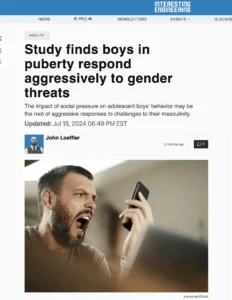[ad_1]
By: Tom Golden
Original Uploading on Substack
There’s a recognizable pattern in study about males and females that typically informs only component of the story. An archetype is domestic physical violence research studies that incorrectly claim women are the sole victims, while neglecting males’s experiences. This happens in various other locations too– like reproductive coercion, teen physical violence, health care, and others. Women’s problems are highlighted, while guys’s are overlooked. When you see this pattern, it’s tough to unsee it.
In this post, we’ll check out a study released in July of 2024, that employs a comparable technique– not by lying, yet by omission. The researchers present just the component of the story that sustains the story they wish to push.
And in this case, it’s clear.
I came across a media short article concerning young boys and threats to their maleness. From the picture listed below that accompanies the short article, I prepared for some significant searchings for on violence or hostility.
The research study claimed to investigate adolescent children’ actions to threats to their masculinity.

Below’s a quick summary of the study:
The research was easy.
207 boys, ages 10 – 14, were given two tests– one on stereotypically feminine topics like blossoms, makeup, and gowns, and one on manly subjects like devices, guns, and autos. Despite their real ratings, the control team was informed they had actually racked up high up on the masculine examination and were congratulated. The kids in the speculative team, nevertheless, were told they scored well on the womanly quiz yet poorly on the manly one. In other words, they were informed they were more like the ladies– meant as a risk to their masculinity. The boys after that took a third quiz, a word conclusion test designed to gauge their degree of hostility. The parents took a series of sets of questions to examine their parenting.
The researchers intended to see if this perceived risk would trigger hostility. (One might also ask if the kid’s hostility might be sparked just due to the fact that they were existed to. Besides, they probably were aware that they knew a lot more regarding weapons and cars than make-up and outfits.)
This type of reaction has actually been researched before and has been recognized as “threat caution,” a typical reaction to standing hazards among males and children, frequently linked to testosterone levels. Researches show that when a male’s status is tested, he is more likely than a female to react aggressively, partly due to higher testosterone. Nevertheless, prepubescent kids normally don’t display this aggression, as they have not yet reached the higher testosterone phase of life. Curiously, in spite of examining what seems this very same phenomenon, the research in question makes no mention of the previous study about hazard alertness. As we will later find, the researcher knew this concept however chose not to include it in the research.
The media article I first read didn’t state threat vigilance or even point out testosterone, though it’s a crucial consider this sort of study. Assuming I could have missed out on something, I searched for other write-ups on the research study and located numerous– but still, no mention of testosterone in any of the write-ups.
What I did locate were media portrayals showing upset, hostile boys, although the scientists themselves really did not assert the kids were violent.
Below’s a quote that appeared in a number of the write-ups: “Beyond just aggression, manhood dangers are connected with a wide variety of unfavorable, antisocial behaviors, such as sexism, homophobia, political bigotry, and also anti-environmentalism,” claimed the researcher, Adam Stanaland. Wait, what? How did we jump from risks to standing to sexism, homophobia, political bigotry, and also anti-environmentalism? This felt like a substantial leap, though it deserves noting the scientists didn’t directly claim young boys were fierce. It seems the media overemphasized that component as seen in the photos, and I doubt the scientists did a lot to remedy it.
Somewhat confused concerning this, I chose to find the actual research study and read it. Testosterone was discussed– when– in the restrictions section, recommending that future researches can explore its role. This made no feeling, given that existing study plainly links testosterone to danger watchfulness and standing protection. This puzzled me and I was identified to discover what was going on so I wrote to the scientist with some inquiries.
He got right back to me and we carried on a discussion. He was a very great fellow and I do value his at first making the effort to field my inquiries. The sense I got was that he wanted pressing the “it’s everything about socialization” ideas. I searched for his history and his graduate job was done at Duke College and he was a member of the Fight it out “Identity and Variety Laboratory” for 5 years. The name states it all. I believe my presumptions were rather close. He was likely to comply with the concepts that socializing is one of the most important element of human development.

When I asked him, “Isn’t risk watchfulness related to testosterone levels?” he reacted: “Basal testosterone and hostility are certainly associated, however here our focus was figuring out whether a social mechanism (i.e., typicality/masculinity danger) might likewise cause hostility amongst teen children (as it does among guys), as well as when/why.”
To put it simply, he didn’t respond to the question. He acknowledged the organic link yet picked to focus only on the social aspect. To me, this resembles examining a car engine yet just looking at the ignition system and ignoring fuel, air, and combustion. A well-rounded research would certainly acknowledge that both testosterone (biological) and socializing play important functions. Omitting one side seems like a willful method to push a story.
I asked the researcher again if he knew research studies revealing testosterone’s duty in risk watchfulness, and he reacted: “Yes, I’m familiar with the intricate role in between testosterone, risk vigilance, status-seeking, and aggressiveness. My previous description was all to say that there is certainly a biological component to aggression, however our outcomes offer proof that there is additionally a noteworthy social element.”
Generally, he’s stating, “Yes, testosterone matters, yet we’re focusing on the social side.” Which’s just how stories are built, by telling just a part of the story. Unfortunately, this study– like numerous others– implies that children might be “taken care of” so they were educated to be much less aggressive when their maleness is intimidated. Yet this neglects the biological aspect. As soon as young boys hit adolescence, higher testosterone levels biologically predispose them to protect their standing. Yet, this critical piece of info is neglected of the conversation.
Puberty
The research study focused on 10 – 14 years of age males from pre-puberty via mid- and late-puberty phases. The scientists made numerous statements that highlighted their views on puberty, including this set:
“We compete that the age of puberty stands for a developmental change in young boys’ psychological partnership with societal definitions of their gender.”
The scientists recognized that adolescence is a crucial factor in these habits, however what does the age of puberty largely signal? It highlights the increase in testosterone degrees in young males. Nonetheless, the scientists never ever state testosterone. Rather, they describe the age of puberty similar to this:
“We compete that puberty represents a developmental change in young boys’ psychological relationship with social interpretations of their sex. Adolescence creates kids to acknowledge themselves– their bodies, their partnerships, and so forth– as being adult-like, which means they should now contend with freshly found societal expectations of manhood: a precarious status that is made, can be shed, and is just restored by complying with inflexible norms, such as aggression.”
Their interpretation suggests that children, upon identifying their growing bodies, should currently deal with “societal prescriptions regarding manhood.” The focus below is entirely on socializing, asserting that boys should comply with rigid societal norms. There’s no mention of testosterone– it’s all framed around social stress, leaving biological factors out of the discussion completely.
Words Completion Test
One more concern I had with this study was their method of measuring aggressiveness: a word completion test. The children were asked to complete spaces like “GU _” (which might be “periodontal” or “gun”) and “_ UNCH” (which could be “punch” or “lunch”). The variety of aggressive words picked apparently showed their level of aggression. I discover it hard to believe this examination properly measures aggression, but the scientist ensured me it had actually been confirmed in various other researches. It appears to me that they are taking a cognitive action and after that anticipating that cognition to forecast a real habits. Appears wonky to me. I was fairly new to the word completion tests and poked around a bit and located that there is considerable conflict regarding this. As there ought to be.
I remain to assume this is a really weak indication however the research obtained magazines to print pictures like this based on picking weapon rather than gum tissue:

These photos, like the other photos in this blog post, indicate not only aggression however hostility. Feels like a jump to me. There is a big difference in between boldy protecting your status, which is what danger watchfulness does, and obvious hostility or violence. Resembles they are trying to suggest the later on. However this is what the media wants. Provide some research study that reveals the men and children are hostile and they will place physical violence on the front page. Whatever happened to words assertive which is similar to hostile? I believe assertive could be a much better word for men protecting their condition. Their protection sometimes might get aggressive but the norm might be merely replying to the obstacle in a strong, logical, and assertive way.
The Sample
The example utilized in the research study additionally increased some concerns. Almost 90 % of the parents included were mothers, and more than two-thirds were solitary parents. This is much over the national average for single-parent households, which floats around 20 – 25 %. Research study shows that kids elevated by single moms are more likely to display aggressiveness, yet the research does not address how this may have influenced the findings.
“Concerning the moms and dads themselves, 87 4 % determined as ladies (mommies) and 12 6 % were men (dads). Many moms and dads were the single main caretaker of the participant (68 6 %) or shared caretaking responsibilities just as with one more person (300%).”
I asked the researcher about the opportunities of a biased sample due to the multitude of single mommies and below is what he claimed:
“I’m not sure that it’s fair to claim that our sample comprising a majority of moms is “solid indicator that [we] had a biased sample.”
Research has shown that although fathers are more included now in their youngster’s caregiving than they used to be, mothers are still significantly overrepresented (link) as the kid’s key caretaker. It makes good sense, after that, that our sample would consist of even more moms than fathers– i.e., it’s depictive and not prejudiced (as a matter of fact, an example with half moms and fifty percent daddies would be prejudiced against the reality of parenting in the U.S.).”
Maybe so, however he doesn’t address the over-abundance of solitary moms in the sample and exactly how that is much from the standard for being a parent in the US today. I particularly pointed out the solitary moms issue and he simply avoided it and concentrated on mothers doing most of day care. The web link he gave was not concerning single mothers, it appeared to be concerning two moms and dad family members. If he had 87 % mommies in his example and they were all from two moms and dad family members, then that would certainly be a different tale. Yet that was not the situation. It was 87 % moms and 2/ 3 rds solitary moms and dads. This tells us that it is likely the majority of those mothers were single parents. A predominance of solitary moms need to be a red flag, however not in his sight. Could the extra of solitary moms have had an influence on the findings?
I do ask yourself.
Framing Moms And Dads as the Issue
One essential takeaway from the study was that boys from conventional, much less wealthy families with parents showing “hegemonic masculinity” were more hostile in feedback to the risk. The device made use of to examine this was the Man Duty Standards Inventory, which includes statements like these:
-
Guy should understand exactly how to repair automobiles.
-
Male needs to be literally hard.
-
It would certainly be horrible if a man appreciated clothing like a lady.
-
A male ought to be able to take care of most things around the house.
-
A male needs to always be the one in charge.
-
Male needs to lead their household.
-
A man needs to always be ready for sex.
If the moms and dads rack up high on this survey they are thought to be instructing their young boys to be “hegemonic”. Hegemonic is seen as something poor.
It’s implied to state that guys are regulating and dominant.
It originates from the writing of R. Connell who time ago became a transwoman. Several academics appear to discover Conell’s publication as the vital word in Masculinities. The parts I have read appear highly anti-male. Connell’s publication brought a good deal of become the research on males where many of his concepts were unceremoniously and artificially grown into researches like in the Consistency to Masculine Norms Stock (CMNI). I did a record on the CMNI and the really suspicious fashion that it was created with a concentrate on just how Connell’s ideas amazingly appeared. You can see that right here.
The scientists seemed to focus on the parental pressure (hegemonic attitudes) as being a prime incentive for the child’s hostile feedbacks. They entitled that variable forced inspiration (PM). When checking out the media short articles it seemed that this adult pressure was being represented as being a huge part of the factors for the hostile responses. This would lend support to the concept that boys could be taken care of if moms and dads would certainly simply stop instructing them to be hegemonic men. However wait a min. The PM variable (parental stress) when coupled with the risk variable (words completion examination) only had a significance rating of p=. 835 Typically a rating of. 05 or below is considered to be substantial so this set was away the mark. Yet they likewise had a variable that indicated the Level of Adolescence for the Kids (PDS) which revealed that the only kids to appear hostile in action to the word completion were children who were in mid to late the age of puberty. When that PDS variable was paired with the threat variable (words conclusion examination) it generated a score of p=. 095 Still not considered considerable but definitely extra significant than the parental stress variable. When both the PM and the PDS were coupled with the risk variable, voila! They obtain a relevance of <



